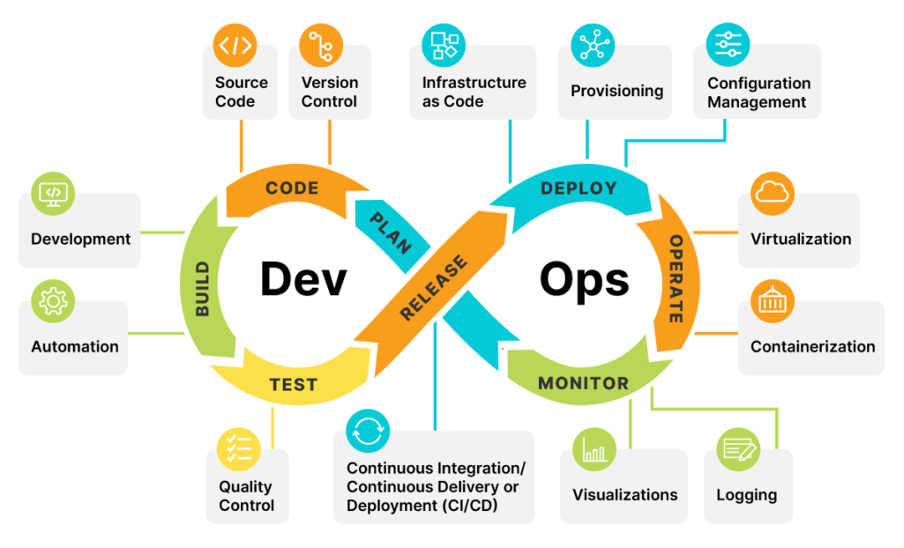DevOps

What is DevOps?
DevOps is a software development methodology that emphasizes collaboration and communication between development and operations teams. It is designed to increase the speed and efficiency of software delivery while also improving the overall quality of the software. The approach is to automate the build, test, and deployment process, implement continuous integration and continuous delivery (CI/CD), monitor and log, and foster a culture of collaboration and communication between development and operations teams. The goal is to break down silos between teams, promote a more agile and responsive organization, and deliver software faster, with higher quality and greater reliability.
How does DevOps Work?

It is designed to streamline the software development process, making it faster and more efficient. Here are some key components of how DevOps works:
Automation: DevOps relies heavily on automation to streamline the build, test, and deployment processes. This helps to reduce the time and effort required to deliver software and helps to ensure that the software is deployed consistently across different environments.
Continuous Integration and Continuous Delivery (CI/CD): DevOps promotes the use of CI/CD, which allows for frequent, small releases of software, rather than infrequent, large releases. This helps to minimize the risk of introducing new bugs or breaking changes and makes it easier to identify and fix issues as they arise.
Monitoring and Logging: DevOps encourages the use of monitoring and logging tools to provide visibility into the performance and health of the software. This allows teams to quickly identify and resolve issues and helps to improve the overall reliability and stability of the software.
Collaboration and Communication: DevOps promotes a culture of collaboration and communication between development and operations teams, breaking down traditional silos and fostering a more agile and responsive organization.
Infrastructure as Code: DevOps practices also include treating infrastructure as code and provisioning and configuring it through code and automation. This approach enables infrastructure to be easily versioned, tested and deployed.
Microservices Architecture: DevOps practices also include the use of Microservices architecture, which breaks down the monolithic application into smaller, loosely coupled, independently deployable services. This approach enables faster development, testing and deployment.
DevOps Lifecycle

The DevOps lifecycle is a set of stages that software goes through from development to production. The DevOps lifecycle typically includes the following stages:
Planning: In this stage, the development team works with stakeholders to define the requirements for the software, and to create a plan for how to build and deliver it.
Code: In this stage, the development team writes the code for the software. This includes using version control tools, such as Git, to manage the code and track changes.
Build: In this stage, the code is compiled and packaged into a releasable form. Build automation tools, such as Jenkins, are used to automate this process.
Test: In this stage, the software is tested to ensure that it meets the requirements and that it is free of bugs. Automated testing tools, such as Selenium, are used to automate this process.
Deploy: In this stage, the software is deployed to a test environment for further testing and a production environment for use by end users. Automated deployment tools, such as Ansible, are used to automate this process.
Monitor: In this stage, the software is monitored for performance and errors. Monitoring tools, such as Nagios, are used to automate this process.
Operate: In this stage, the software is operated and maintained. This includes troubleshooting issues, applying updates and patches, and scaling the software as necessary.
Benefits of DevOps :
DevOps is a methodology that aims to streamline the software development process by promoting collaboration and communication between development and operations teams. There are several benefits to using DevOps, including:
Faster software delivery: DevOps automates the build, test, and deployment process, making it faster and more efficient to deliver software. This allows organizations to respond more quickly to changing market conditions and customer needs.
Improved quality: DevOps uses continuous integration and continuous delivery (CI/CD) to minimize the risk of introducing new bugs or breaking changes. This helps to ensure that the software is of high quality and that issues are identified and resolved quickly.
Increased reliability: DevOps uses monitoring and logging tools to provide visibility into the performance and health of the software. This allows teams to quickly identify and resolve issues, improving the overall reliability and stability of the software.
Greater scalability: DevOps practices enable infrastructure as code, and microservices architecture, which allows teams to easily provision and configure infrastructure and services. This makes it easier to scale the software as needed.
Better collaboration and communication: DevOps promote a culture of collaboration and communication between development and operations teams, breaking down traditional silos and fostering a more agile and responsive organization.
Cost savings: DevOps practices, such as automation, continuous integration, and delivery, monitoring and logging, infrastructure as code, and microservices architecture, help organizations to reduce costs by increasing efficiency, reducing errors and downtime, and improving the overall quality of the software.
Challenges of adopting DevOps
While the adoption of DevOps can bring many benefits, there are also challenges that organizations may face when implementing it. Some of the main challenges include:
Resistance to change: DevOps requires a significant cultural shift within an organization, and some team members may be resistant to change. This can make it difficult to implement new processes and tools and to get buy-in from all stakeholders.
Lack of collaboration and communication: DevOps requires close collaboration and communication between development and operations teams. However, if these teams have traditionally worked in silos, it can be difficult to break down these barriers and establish effective communication channels.
Limited skills and knowledge: DevOps require a specific set of skills and knowledge, such as expertise in automation and configuration management tools. If the organization lacks these skills, it may be difficult to implement DevOps effectively.
Lack of standardization: DevOps requires standardization of processes, tools, and infrastructure, but if an organization has multiple teams working on different projects, it can be challenging to maintain consistency across the board.
Security concerns: As DevOps promotes automation and faster deployment, it could lead to increased security risks if security is not integrated in the process. If security is not considered from the beginning, it could lead to vulnerabilities in the final product.
Test and deployment challenges: DevOps requires a high degree of automation in testing and deployment, but if the testing process is not automated, it can be difficult to test new features and updates quickly.
Managing infrastructure: As DevOps often requires the use of cloud infrastructure, it can be challenging to manage and scale the infrastructure effectively.
Monitoring and logging: DevOps require effective monitoring and logging to ensure the reliability and performance of the software. However, it can be difficult to collect and analyze the data from these tools in a meaningful way.
DevOps Market

DevOps has gained significant traction in the market in recent years, as more and more organizations are recognizing the benefits of streamlining the software development process. According to a report by MarketsandMarkets, the DevOps market is expected to grow from $3.85 billion in 2020 to $10.31 billion by 2025, at a CAGR of 22.5%.
One of the major drivers for the growth of the DevOps market is the increasing demand for faster software delivery. Organizations are under pressure to respond quickly to changing market conditions and customer needs, and DevOps enables them to deliver software faster and more efficiently. Additionally, the adoption of cloud computing and the increasing use of agile methodologies are also driving the growth of the DevOps market.
The market is segmented by solution, service, organization size, deployment model, vertical, and region. Based on the solution, the market is segmented into continuous integration, continuous testing, continuous monitoring, and others. Based on the service, the market is segmented into professional services, consulting services, and managed services. Based on the organization size, the market is segmented into small and medium-sized enterprises and large enterprises. Based on the deployment model, the market is segmented into on-premises and cloud.
The DevOps market is also segmented by vertical, with the healthcare, BFSI, retail, IT and telecom, and government verticals expected to have the largest share of the market. In terms of region, North America is expected to have the largest share of the market, driven by the presence of many technology companies and the early adoption of DevOps in the region. However, the Asia Pacific region is expected to grow at the highest CAGR during the forecast period, driven by the increasing adoption of DevOps in the region.
